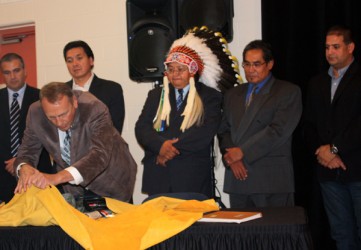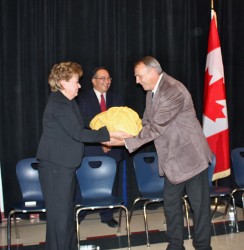Article Origin
Volume
Issue
Year
Various people gathered at the Whitecap Dakota First Nation community school to witness the creation of an education bundle and the signing of an agreement that was the first of its kind in Saskatchewan.
Indian Affairs and Northern Development of Canada(INAC) Minister John Duncan was on hand at the October 14 event to represent the federal government in its partnership with the Saskatoon Tribal Council(STC) and the Province of Saskatchewan. Elders, government officials, band chiefs, band members, and students looked on as a document was signed by Minister Duncan, tribal council chief Felix Thomas, and the province’s Minister of Education Donna Harpauer.
“We are keen and ready to work with willing partners to improve First Nations education,” said Minister Duncan referring to schools in the tribal council region. “To help mark the importance of this partnership, we are creating an education bundle which will serve as both a symbol and a tool.”
The hide-bound bundle with four ties was created specifically for the joint agreement focused on meeting specific needs and giving students a greater understanding of First Nations culture and people. It targets the approximately 11,000 First Nation students attending band and provincial schools in the tribal council area.
The bundle held many items including a treaty document placed into the bundle by Chief Thomas, a Canadian flag from Minister Duncan, and a brass bell from Minister Harpauer.
“This agreement recognizes the need to work together as leaders and educators, both on and off reserve,” said Chief Thomas. “To develop and refine the learning environments, tools and systems this promising group of young people needs to succeed.”
Minister Harpauer also looked forward to the working partnership to improving First Nations educational achievement. In her speech, she addressed the students sitting in the crowd. “I want to say to the students, ‘you are why we are here,’” she told them.
Currently there are no specific funding amounts set out, said STC’s acting director of education John Barton in a Sage interview, as partners have just begun to work together to create an educational partnership.
The agreement was based on a proposal the tribal council submitted to INAC to access funds from a $30 million pot of cash made available for regional First Nations governments seeking to develop educational programming. These earmarked INAC funds were approved to help First Nations students in provincial schools around Saskatchewan and band schools in the Whitecap, Kinistin, Mistawasis, Muskeg Lake, Muskoday, One Arrow, and Yellow Quill First Nations.
Barton said the idea for the bundle came from First Nations Elders of the Cree, Saulteaux, Sioux and Dakota groups who had gathered to speak on new education partnerships.
“We tried to find something that was connected to education that was important in all the cultures (of the) communities,” Barton said. “In terms of actually putting it together, Louise Smokeyday and Albert Scott were two key people from Kinistin First Nation, who helped.”
“The bundle is like a baby,” said Scott, explaining to the crowd the bundle’s meaning. The handing over of the bundle is like saying “my children’s lives are in your hands,” he added.
After the education bundle changed hands from Chief Thomas to Minister Harpauer to Minister Duncan, it was taken by an elder, after which all parties exchanged gifts of Native paintings. Master of Ceremonies George Lafond told the crowd gathered that gift giving was a traditional practice in treaty making to solidify relationships and bring friends together.
Afterward, Minister Duncan spoke briefly with reporters and was asked about recent concerns brought up at a Regina rally about the $2,000 gap per student in Saskatchewan’s First Nations compared to provincial schools.
“We understand there are funding issues about that post-secondary (and) K-12 level,” Minister Duncan said. “So we’re addressing those along with the provincial governments, because they deliver a lot of the educational services.”
He added the two percent cap on INAC funding for education has not always applied in the strictest sense of the word because in these types of agreements INAC puts extra money into educational partnership proposals.
“Yes, this money goes into the education partnership program, which is over and above the 2%(funding cap),” he told reporters.
Political columnist John Ivison of the National Post, stated in his October 18 column that as many advocates have argued, a new First Nations Education Act is sorely needed to replace the current outdated Indian Act legislation governing First Nations education.
“Advocates of new legislation say that the piecemeal reforms currently emerging, though a step in the right direction, are too tentative,” Ivison argued.
“Current processes are too little and too slow,” he said and added in the end it results in another lost generation or two of First Nations who should be entering Canada’s workforce.
As for the education agreement, it will seek to develop joint education action plans, support student transitions between grade levels and school systems, assess ongoing student learning and skills, enhance data management and collection, engage families and communities in schools, and share professional development and curricular resources.
Photo Caption: After signing a tripartite agreement on Oct. 14, Saskatchewan’s Minister of Education Donna Harpauer, Minister of Indian Affairs and Northern Development John Duncan (right) and Saskatoon Tribal Council Chief Felix Thomas (center) created a symbolic education bundle to demonstrate the value and care put into the agreement by all parties.
- 2524 views


